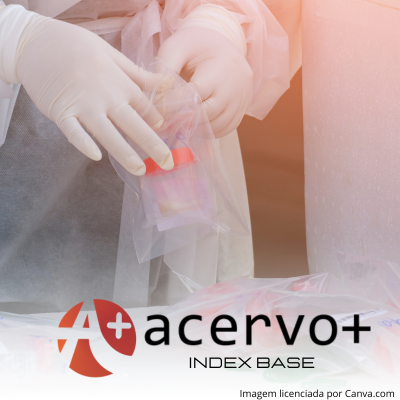Impacto de diferentes protocolos pré-analíticos na concentração de proteínas totais em saliva humana
##plugins.themes.bootstrap3.article.main##
Resumo
Objetivo: Avaliar e comparar a concentração proteica de amostras de saliva total submetidas a alterações metodológicas no preparo pré-analítico. Métodos: Saliva total de 10 participantes de 23 a 65 anos (31.10±4.059) e o fluxo salivar foi calculado (mL/min). As amostras foram fracionadas e divididas em seis diferentes grupos. Cada grupo (G1-G6) correspondeu a um diferente tipo de preparo pré-analítico, combinando os seguintes fatores: centrifugação, uso de inibidor, temperatura e tempo de conservação. A concentração de proteínas totais foi avaliada pelo método do ácido bicinconínico em duplicata, e os dados analisados estatisticamente (p<0.05). Resultados: A concentração média de proteínas totais demonstrou uma correlação negativa significativa com o fluxo salivar em G1 (r= -0,794; p= 0,020), G4 (r= -0,690; p= 0,027) e G5 (r= -0,626; p= 0,05). Proteínas totais e idade demonstraram correlação significativa em G3 (rho= 0,762; p= 0,01). A concentração de proteínas totais média não diferiu de forma significante entre grupos, F(5,45)= 1,132, (p= 0,358). Igualmente não foram observadas diferenças ao comparar as médias de proteínas totais normalizadas com base no fluxo salivar, F(5,45) = 2,068, (p= 0,087). Conclusão: Os diferentes protocolos no tratamento das amostras de saliva não demonstraram alterações quantitativas significantes nas concentrações de proteínas totais neste fluido.
##plugins.themes.bootstrap3.article.details##
Copyright © | Todos os direitos reservados.
A revista detém os direitos autorais exclusivos de publicação deste artigo nos termos da lei 9610/98.
Reprodução parcial
É livre o uso de partes do texto, figuras e questionário do artigo, sendo obrigatória a citação dos autores e revista.
Reprodução total
É expressamente proibida, devendo ser autorizada pela revista.
Referências
2. BHAMIDIMARRI PM, et al. Assessing the impact of storage conditions on RNA from human saliva and its application to the identification of mRNA biomarkers for asthma. Frontiers in Molecular Biosciences, 2024; 11:1363897.
3. BHUPTANI D, et al. Age and gender related changes of salivary total protein levels for forensic application. The Journal of Forensic Odontostomatology, 2018;36(1):26-33.
4. CHIAPPIN S,et al. Saliva specimen: A new laboratory tool for diagnostic and basic investigation. Clinica chimica acta; international journal of clinical chemistry, 2007; 383:30-40.
5. CHEVALIER F, et al. Proteomic studies of saliva: A Proposal for Standardized Handling of Clinical Samples. 2007; Clinical Proteomics, 2007; 3:13-21.
6. CROUCH DJ. Oral fluid collection. The neglected variable in oral fluid testing. Forensic Science International 2005; 150: 165-173.
7. DHANARATHNA S,et al. Estimation and comparison of salivary flow rate and its composition in diabetic patients and nondiabetic patients: A pilot study. Journal of Oral and Maxillofacial Pathology, 2021; 25(2):232-238.
8. DURUK G e LALOGLU E. Relationship Between Dental Caries and YKL-40 Levels in Saliva. Journal of Clinical Pediatric Dentistry, 2022; 46(2):137-142.
9. ESSER G, et al. Sample Stability and Protein Composition of Saliva. Biomarker Insights, 2008; 3: 25-37.
10. FONTELES CS, et al. Association of free amino acids with caries experience and mutans streptococci levels in whole saliva of children with early childhood caries. Arch Oral Biol. 2009 Jan;54(1):80-5.
11. GONZÁLEZ-HERNÁNDEZ JM, et al. A. Influence of Sampling Conditions, Salivary Flow, and Total Protein Content in Uric Acid Measurements in Saliva. Antioxidants (Basel, Switzerland). 2019; 8(9):389.
12. HELMERHORST EJ e OPPENHEIM FG. Saliva: a dynamic proteome. Journal of Dental Research, 2007; 86(8):680-93.
13. HOEK GH, et al. Toothbrushing affects the protein composition of whole saliva. European Journal of Oral Sciences, 2002;110(6):480-1.
14. JONG EP, et al. Sample collection and handling considerations for peptidomic studies in whole saliva; implications for biomarker discovery. Clinica Chimica Acta, 2011; 412: 2284-2288.
15. KHURSHID Z,, et al. Biochemical analysis of oral fluids for disease detection. Advances in Clinical Chemistry, 2021;100:205-253.
16. LIU G, et al. Effect of protese inhibitors on the quantitative and qualitative assessment of oral microbes. FEMS Microbiology Letters, 2010; 312(1): 63-70.
17. MIZUHASHI F, et al. Protein Ingredient in Saliva on Oral Dryness Patients Caused by Calcium Blocker. Geriatrics (Basel, Switzerland), 2020;5(4):70.
18. MORTAZAVI H, et al. Extensive comparison of salivary collection, transportation, preparation, and storage methods: a systematic review. BMC Oral Health, 2024; 24(1):168.
19. PAPPA E, et al. Proteomic advances in salivary diagnostics. Biochimica et Biophysica Acta. Proteins and Proteomics, 2020; (11):140494.
20. THOMADAKI H, et al. Whole-saliva Proteolysis and Its Impact on Salivary Diagnostics. Journal of Dental Research, 2011; 90(11) 1325-1330
21. VELJOVIĆ T, et al. The influence of periodontal disease treatment on 8-hydroxy-deoxyguanosine concentrations in saliva and plasma of chronic periodontitis patients. Acta Clinica Croatica, 2020;59(4):615-622.

